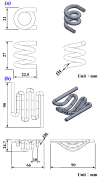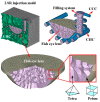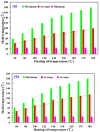Development of an Injection Mold with High Energy Efficiency of Vulcanization for Liquid Silicone Rubber Injection Molding of the Fisheye Optical Lens
- PMID: 37447514
- PMCID: PMC10346709
- DOI: 10.3390/polym15132869
Development of an Injection Mold with High Energy Efficiency of Vulcanization for Liquid Silicone Rubber Injection Molding of the Fisheye Optical Lens
Abstract
Liquid silicone rubber (LSR) techniques are experiencing exponential growth, particularly in the field of high technology due to the low-temperature flexibility, superior heat stability, chemical resistance, and aging resistance of LSR components. Enhancing the curing rate of LSR parts in liquid silicone rubber injection molding is an important research topic. In this study, an injection mold with high energy efficiency of vulcanization for the liquid silicone rubber injection molding of a fisheye lens was developed and implemented. The LSR injection mold has a conformal heating channel (CHC) and conformal cooling channel (CCC) simultaneously. The function of CHC is to enhance the curing rate of a fisheye lens in the LSR injection molding to meet the requirements of sustainable manufacturing. The curing rates of a fisheye lens were numerically examined using the Moldex3D molding simulation software. It was found that the curing rate of the fisheye optical lens cured by injection mold with CHC was better than that of the injection mold with a conventional heating channel. The curing efficiency could be increased by about 19.12% when the heating oil temperature of 180 °C was used to cure the fisheye optical lens. The simulation results showed that the equation y = -0.0026x3 + 1.3483x2 - 232.11x + 13,770 was the most suitable equation for predicting the curing time (y) through the heating oil temperature (x). It was found that the trend of the experimental results was consistent with the simulation results. In addition, the equation y = -0.0656x2 + 1.5827x - 0.894 with the correlation coefficient of 0.9974 was the most suitable equation for predicting the volumetric shrinkage of the fisheye optical lens (y) through the heating oil temperature (x). The volume shrinkage of the fisheye optical lens cured by injection mold with CHC was very similar to that of the injection mold with a conventional heating channel. The maximum volume shrinkage of the fisheye optical lens cured at 180 °C was about 8.5%.
Keywords: conformal cooling channel; conformal heating channel; curing rate; energy efficiency; liquid silicone rubber; sustainable manufacturing.
Conflict of interest statement
The authors declare no conflict of interest.
Figures





















Similar articles
-
Development of a Silicone Rubber Mold with an Innovative Waterfall Cooling Channel.Polymers (Basel). 2024 Jan 16;16(2):256. doi: 10.3390/polym16020256. Polymers (Basel). 2024. PMID: 38257055 Free PMC article.
-
Enhancing Surface Temperature Uniformity in a Liquid Silicone Rubber Injection Mold with Conformal Heating Channels.Materials (Basel). 2023 Aug 22;16(17):5739. doi: 10.3390/ma16175739. Materials (Basel). 2023. PMID: 37687431 Free PMC article.
-
Development of an Epoxy-Based Rapid Tool with Low Vulcanization Energy Consumption Channels for Liquid Silicone Rubber Injection Molding.Polymers (Basel). 2022 Oct 26;14(21):4534. doi: 10.3390/polym14214534. Polymers (Basel). 2022. PMID: 36365527 Free PMC article.
-
In-Mold Sensors for Injection Molding: On the Way to Industry 4.0.Sensors (Basel). 2019 Aug 15;19(16):3551. doi: 10.3390/s19163551. Sensors (Basel). 2019. PMID: 31443164 Free PMC article. Review.
-
A Review on Injection Molding: Conformal Cooling Channels, Modelling, Surrogate Models and Multi-Objective Optimization.Polymers (Basel). 2025 Mar 28;17(7):919. doi: 10.3390/polym17070919. Polymers (Basel). 2025. PMID: 40219308 Free PMC article. Review.
Cited by
-
Evaluating the Cooling Efficiency of Polymer Injection Molds by Computer Simulation Using Conformal Channels.Polymers (Basel). 2023 Oct 10;15(20):4044. doi: 10.3390/polym15204044. Polymers (Basel). 2023. PMID: 37896288 Free PMC article.
-
Development of a Silicone Rubber Mold with an Innovative Waterfall Cooling Channel.Polymers (Basel). 2024 Jan 16;16(2):256. doi: 10.3390/polym16020256. Polymers (Basel). 2024. PMID: 38257055 Free PMC article.
-
Enhancing Surface Temperature Uniformity in a Liquid Silicone Rubber Injection Mold with Conformal Heating Channels.Materials (Basel). 2023 Aug 22;16(17):5739. doi: 10.3390/ma16175739. Materials (Basel). 2023. PMID: 37687431 Free PMC article.
References
-
- Woitschach F., Kloss M., Schlodder K., Borck A., Grabow N., Reisinger E.C., Sombetzki M. In Vitro Study of the Interaction of Innate Immune Cells with Liquid Silicone Rubber Coated with Zwitterionic Methyl Methacrylate and Thermoplastic Polyurethanes. Materials. 2021;14:5972. doi: 10.3390/ma14205972. - DOI - PMC - PubMed
-
- Kuo C.C., Lin J.X. A cost-effective method for rapid manufacturing polymer rapid tools used for liquid silicone rubber injection molding. Int. J. Adv. Manuf. Technol. 2019;104:1159–1170. doi: 10.1007/s00170-019-04000-w. - DOI
-
- Kuo C.C., Lin J.X. Fabrication of the Fresnel lens with liquid silicone rubber using rapid injection mold. Int. J. Adv. Manuf. Technol. 2019;101:615–625. doi: 10.1007/s00170-018-2964-z. - DOI
-
- Kuo C.C., Chen W.H., Lin Y.X., Gao Q., Gian S.J., Xiao C.X. Effects of different fillers on the silicone rubber mold with conformal cooling channels. Int. J. Adv. Manuf. Technol. 2020;108:1509–1525. doi: 10.1007/s00170-020-05508-2. - DOI
LinkOut - more resources
Full Text Sources

